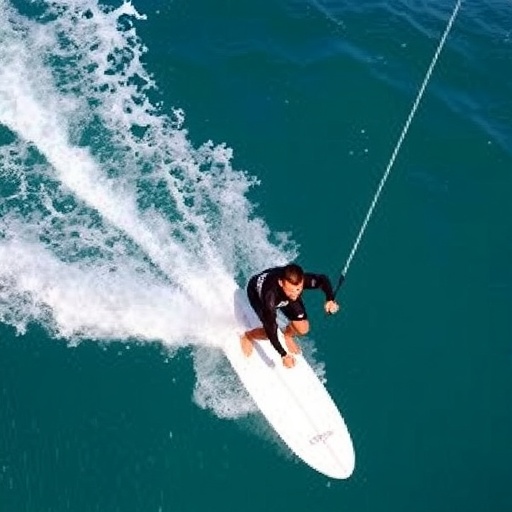In the realm of sports science, the integration of technology and traditional athletic training is transforming how performance is analyzed and enhanced. A recent study titled “Monitoring sprint-paddling technique in elite and sub-elite surfers using inertial sensors,” authored by Gosney, Minahan, Parsonage, and their colleagues, epitomizes this innovative approach. The research zeroes in on the elusive art of surf paddling, an essential skill that separates the elite surfers from their sub-elite counterparts. With the application of inertial sensors, the authors meticulously dissected the paddling techniques, shedding light on the subtleties that dictate success on the waves.
The study’s primary objective revolves around understanding how paddle techniques affect overall surfing performance. In an environment where split-second decisions can make the difference between conquering a wave and tumbling into the surf, analyzing these techniques provides surfers with crucial performance insights. Instead of relying solely on subjective observations, the authors leverage data-driven analysis to inform training and technique improvements, which is revolutionary in a sport deeply rooted in instinct.
By employing inertial sensors, the researchers obtained an extensive array of quantitative data regarding paddling movements. These sensors capture a wide variety of metrics: from stroke frequency to the acceleration of arm movements, all contributing to a comprehensive understanding of the paddling mechanic. This detailed data allows for real-time feedback, which is invaluable not only for elite surfers who rely on precision but also for aspiring sub-elite surfers who aim to close the performance gap.
The analysis presented in this research bridges a significant gap in the existing literature surrounding surf training methodologies. Traditionally, paddling techniques were assessed through qualitative measures – an observation of surface performance rather than an in-depth analysis of the mechanics involved. The introduction of inertial sensors provides an objective evaluation method, representing a paradigm shift in surf coaching and athlete development.
The findings of this study are not only critical for competitive surfers but also signify advancements in sports technology. The integration of these sensors into training regimens can help athletes refine their techniques and strategies. Coaches can now make data-informed decisions, tailoring training sessions to each athlete’s unique strengths and weaknesses, thereby enhancing individual performance.
The implications of the research extend into the design of future surf training programs. With real-time data from inertial sensors, training can become more targeted and specific, focusing on aspects of paddling that an athlete might be underperforming in. This targeted approach could lead to more efficient training cycles and faster improvement rates, particularly among those athletes striving for elite status.
Indeed, as surfing continues to evolve into a highly competitive sport, the role of technology in enhancing athletic performance grows ever more critical. The use of inertial sensors may pave the way for future innovations, including sophisticated virtual coaching platforms that utilize this data for live feedback and practice adjustments. The synergy between technology and technique could soon become the standard by which athletes prepare for competition.
Additionally, the study highlights the broader implications of such technology beyond the surfing community. Other sports, which require precise motor skills and rapid decision-making, could benefit from similar setups. The cross-disciplinary applications reveal the potential for widespread advancements in athletic training and performance management across various sports disciplines.
The commitment to research exhibited by Gosney and her colleagues sets a new benchmark for sports scholars. By incorporating technology into traditional training methods, they are paving the way for further studies that marry biomechanics with machine learning. As researchers gain a deeper understanding of motion metrics and physiological responses, the potential for refined training strategies increases exponentially.
Furthermore, the ability to analyze paddling techniques can have repercussions on injury prevention strategies within the surfing community. By understanding the mechanics of paddling, coaches may identify vulnerable areas susceptible to injury, allowing for preventive measures to be put in place. This proactive stance toward athlete welfare undoubtedly resonates with both professional organizations and amateur surf schools alike, emphasizing a culture of caring alongside competitive excellence.
The intricate balance of power, speed, and technique necessary for effective paddling is encapsulated within this study, which serves as both a reminder and an education for surfers at all levels. It highlights the importance of scientific advancements in understanding sports performance and maximizing potential. The knowledge gleaned from inertial sensors can empower surfers to achieve personal bests while minimizing the risk of overexertion or injury.
As we analyze the future of sports technology, the fruits of this research stand as a testament to innovation. With the ongoing developments in sensor technology and data analytics, the landscape of athletic training will likely become increasingly sophisticated, offering more athletes the tools they need to excel. The marriage of traditional sports with cutting-edge technology is just beginning, and the results promise to redefine the boundaries of athletic performance.
In conclusion, the insights provided by the study underscore the significance of leveraging technology for enhancing competitive performance in surfing. By monitoring sprint-paddling techniques with inertial sensors, researchers unlock a rich data repository that can profoundly influence both training methodologies and athlete outcomes. As this research continues to inspire and facilitate further exploration in the field, surfers around the globe may soon find themselves riding waves not just with skill acquired through practice, but with data-driven strategies that elevate their performance to unprecedented heights.
Subject of Research: Surf paddling technique in elite and sub-elite surfers.
Article Title: Monitoring sprint-paddling technique in elite and sub-elite surfers using inertial sensors.
Article References:
Gosney, S., Minahan, C., Parsonage, J. et al. Monitoring sprint-paddling technique in elite and sub-elite surfers using inertial sensors. Sports Eng 28, 44 (2025). https://doi.org/10.1007/s12283-025-00524-5
Image Credits: AI Generated
DOI: https://doi.org/10.1007/s12283-025-00524-5
Keywords: Surfing, paddling technique, inertial sensors, sports science, athletic performance, data-driven coaching.
Tags: biomechanics of surf paddlingdata-driven training methods for surferselite surfer performance analysisenhancing athletic performance in surfinginertial sensors in sports scienceoptimizing paddling techniques for surfingperformance metrics for elite surfersquantitative analysis of surf paddlingsprint-paddling techniques in surfingtechnology in surf trainingtraditional vs modern training in surfingunderstanding surfing dynamics through data





